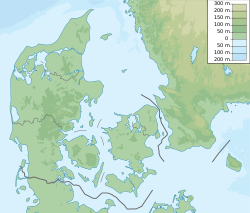Gram Formation
| Gram Formation | |
|---|---|
| Stratigraphic range: Tortonian ~ | |
 Gram Clay Pit, the prime source of fossils from the Gram Formation | |
| Type | Formation |
| Lithology | |
| Primary | Claystone |
| Location | |
| Coordinates | 55°18′N 9°06′E / 55.3°N 9.1°E |
| Approximate paleocoordinates | 55°36′N 8°06′E / 55.6°N 8.1°E |
| Region | Jutland |
| Country | |
| Type section | |
| Named for | Gram |
The Gram Formation is a geological formation in Gram, Denmark. It preserves fossils dating from the Miocene period. The formation consists of three layers: the glauconite-rich, the Gram Clay, and the Gram sand. The sediments in the formation were deposited in an open marine depositional environment known as the Gram Sea.
Fossil content[edit]
Many fossils of new species have been discovered in the formation, including those of the beaked-whale Dagonodum mojnum[1] and the mollusk species Pseudocochlespira gramensis,[2] as well as specimens of better-known species such as Carcharodon megalodon.[3]
See also[edit]
References[edit]
- ^ Ramassamy, Benjamin; Lauridsen, Henrik (October 2019). "A new specimen of Ziphiidae (Cetacea, Odontoceti) from the late Miocene of Denmark with morphological evidence for suction feeding behaviour". Royal Society Open Science. 6 (10): 191347. Bibcode:2019RSOS....691347R. doi:10.1098/rsos.191347. PMC 6837206. PMID 31824732.
- ^ http://natuurtijdschriften.nl/download?type=document&docid=674554[dead link][full citation needed]
- ^ Almgreen, S. E. Bendix (15 November 1983). "Carcharodon megalodon from the Upper Miocene of Denmark, with comments on elasmobranch tooth enameloid: coronoïn". Bulletin of the Geological Society of Denmark. 32: 1–32. CiteSeerX 10.1.1.514.1782. doi:10.37570/bgsd-1983-32-01. S2CID 53311833. NAID 10012345550.

